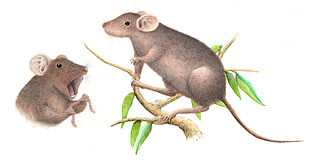
Apomys, commonly known as earthworm mice, is a genus of rodent endemic to the Philippines. Mice belonging to this genus are generally called Philippine forest mice and can be found on most islands of the Philippines except in Palawan, the Sulu Archipelago, and the Batanes and Babuyan group of islands.

The Mindanao montane forest mouse is a species of rodent in the family Muridae. It is found only in the Philippines.

The short-footed Luzon tree rat or greater dwarf cloud rat is a species of rodent in the family Muridae. It is found only in the Philippines, specifically in northern Luzon. Its natural habitat is tropical moist montane forests.

The Mindanao mountain rat or long-tailed moss mouse, is a species of rodent in the family Muridae. It is found only in the Philippines, where it is present at high altitudes in the Kitanglad Mountain Range on the island of Mindanao.

Limnomys is a genus of rodent in the family Muridae endemic to Mindanao, Philippines. It contains the following species:

The Palawan soft-furred mountain rat is a species of rodent in the family Muridae. It is the only species in the genus Palawanomys. It is found only in Palawan, Philippines, and has been recorded on Mount Mantalingajan.

The long-footed rat is a species of rodent in the family Muridae.

The spiny long-footed rat, also known as the Mindanao spiny rat, is a species of rodent in the family Muridae.
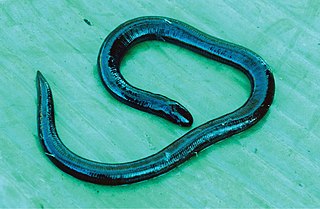
Ichthyophis mindanaoensis, also known as Todaya caecilian or Mindanao Island caecilian, is a species of caecilian in the family Ichthyophiidae. It is endemic to the island of Mindanao, the Philippines.
The Mindanao brown dove is a threatened species of bird in the family Columbidae. It is endemic to forests on the Philippine islands of Mindanao and Basilan, but it has not been recorded from the latter island since 1937. It is threatened by habitat loss and hunting. Until recently, it was considered conspecific with the Tawitawi brown dove and collectively called the dark-eared brown dove.
Podogymnura truei, also known as the Mindanao gymnure, Mindanao moonrat, or Mindanao wood shrew, is a mammal of the family Erinaceidae. It is endemic to the Mindanao islands of the Philippines. Erinaceidae is a family of small mammals that include the gymnures, also known as the silky furred moonrats, and the hedgehogs. Animals belonging to this family are significant because they are among the oldest known placental mammals that are alive. Gymnures are relatives of hedgehogs but lack the prickly spines. Two species are categorized in the genus Podogymnura: P. aureospinula and P. truei. Both species share a close resemblance to the moonrat Echinosorex gymnura, which is commonly found on the Borneo, Sumatra, and the Malay Peninsulas.
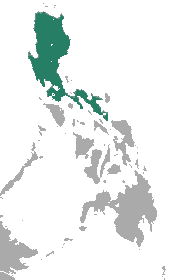
The Luzon fruit bat is a species of megabat in the family Pteropodidae. It is monotypic within the genus Otopteropus. It is endemic to the Philippines. Its natural habitat is subtropical or tropical dry forest. It is threatened by habitat loss.

The small rufous horseshoe bat is a species of bat in the family Rhinolophidae. It is endemic to the Philippines on the island of Camiguin, Catanduanes, Luzon, Mindanao and Mindoro at elevations from sea level to 1,000m.
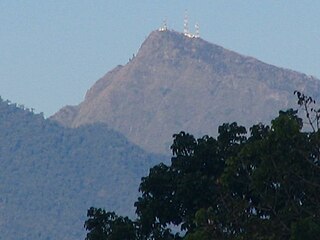
Mount Kitanglad is an inactive volcano located in the Kitanglad Mountain Range in Bukidnon province on Mindanao island. It is the fourth highest mountain in the Philippines and has an approximate height of 2,899 metres (9,511 ft). It is located between Malaybalay City and the municipalities of Lantapan, Impasugong, Sumilao, and Libona. It is home to one of the Philippines' few remaining rainforests.

Kitanglad Mountain Range is a mountain range that dominates the northern central portion of the province of Bukidnon. It occupies portions of eight of the municipalities and cities in the province such as Talakag, Baungon, Libona, Manolo Fortich, Impasugong, Lantapan and Malaybalay. The range is one of the few remaining rainforests in the Philippines, hosting one of the most important diverse species of rare and endemic wildlife such as the Philippine eagle. Five of its peaks have very high elevations: Mount Dulang-dulang, the highest at 2,941 meters; Mount Kitanglad at 2,899 meters; Mount Maagnaw at 2,742 meters; Mount Lumuluyaw at 2,612 meters; and Mount Tuminungan at 2,400 meters.
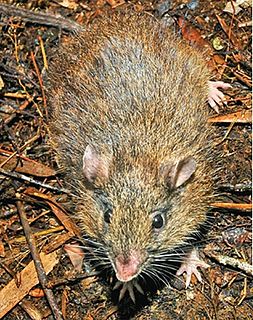
The Hamiguitan hairy-tailed rat is one of five species of rodent in the genus Batomys. It is in the diverse family Muridae. This species is found only in the Philippines. is a yellow-brown animal with a long furry tail, weighs about 175 grams, and is related to several other species known in Central Mindanao, Dinagat Island and Luzon. It lives only in an area that's at least 950 meters high, and in dwarf mossy forests less than 10 square kilometers.

The Katanglad shrew-mouse, also known as the Kitanglad shrew-mouse is a species of rodent in the family Muridae. It is known only from one specimen taken at 2250 m on Mount Kitanglad, Bukidnon Province, Philippines.

The Kalinga shrew mouse is a rodent of the genus Soricomys found in the northern province of Kalinga, island of Luzon, in the northern Philippines.

















